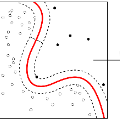Anomaly detection (AD) tries to identify data instances that deviate from the norm in a given data set. Since data distributions are subject to distribution shifts, our concept of ``normality" may also drift, raising the need for zero-shot adaptation approaches for anomaly detection. However, the fact that current zero-shot AD methods rely on foundation models that are restricted in their domain (natural language and natural images), are costly, and oftentimes proprietary, asks for alternative approaches. In this paper, we propose a simple and highly effective zero-shot AD approach compatible with a variety of established AD methods. Our solution relies on training an off-the-shelf anomaly detector (such as a deep SVDD) on a set of inter-related data distributions in combination with batch normalization. This simple recipe--batch normalization plus meta-training--is a highly effective and versatile tool. Our results demonstrate the first zero-shot anomaly detection results for tabular data and SOTA zero-shot AD results for image data from specialized domains.
翻译:异常探测(AD) 试图识别偏离特定数据集规范的数据实例。 由于数据分布受到分布变化的影响, 我们的“ 正常性” 概念也可能漂移, 从而需要零发适应方法来检测异常现象。 然而, 目前零发自动检测方法依赖于在其域内受限制的基础模型(自然语言和自然图像), 成本高昂, 且往往专有, 要求采用替代方法。 在本文中, 我们提出一种简单而高效的零发自动处理法, 与各种既定的自动处理法相兼容。 我们的解决方案依赖于对现成异常探测器( 如深层SVDD) 进行与批次正常化相结合的一组相关数据分布培训。 这种简单的食谱常规化加上元培训是一种非常有效和实用的工具。 我们的结果显示了表格数据首个零发异常检测结果和专门领域图像数据SOTA零发自动评估结果。




